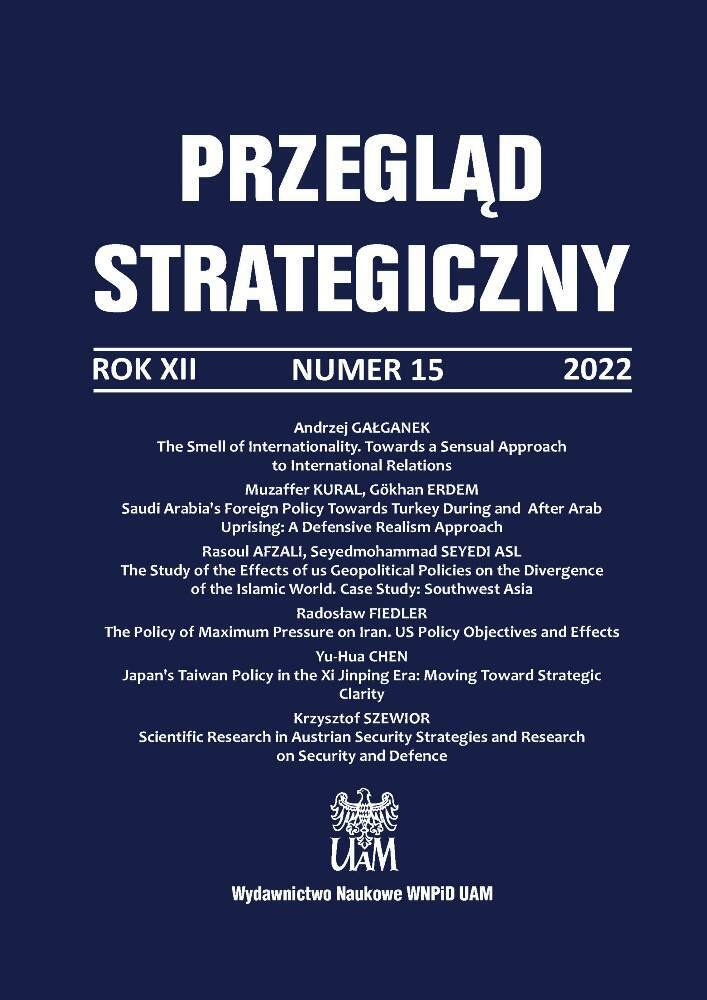Abstract
The article brings attention to the gap in the research on peacebuilding from the perspective of realist theories. Started by Johan Galtung, the peacebuilding field has been largely influenced by his understanding of peace and violence, as well as by the peace studies discipline itself. An Agenda for Peace turned the theoretical concept into international practice, and the liberal spirit accompanying it imprinted on the research approaches that guide peacebuilding activities. Executed in the form of democratic transformation and statebuilding, peacebuilding operations often did not bring the expected results and called on a lot of criticism. Besides, throughout the decades dominating approaches (liberalism complemented by institutional and critical IR theories) have not been able to explain the continuous unattainability of sustainable peace and exacerbation of violence. A little attention has been given to peacebuilding by the realist theory, which has limited interest in local conflicts. In this aspect, the article aims to discuss how the realist theories have been addressing the topic of peacebuilding so far, analyse what are the main assumptions related to peacebuilding from a realist perspective; and assess if the realist theories can be helpful in resolving the problem of peacebuilding ineffectiveness. The article opens further discussion on whether the realist perspective and its focus on states’ interests, rather than (democratic and liberal) values and institutions, can be used for analysing the problems of the peacebuilding process and can help to better understand situations, where it is ineffective.
References
Balcerowicz B. (2002), Pokój i "nie-pokój". Na progu XXI wieku, Warsaw.
Brosnan S. F. (2021), Building Peace through Social Relationships. A Primatological Perspective, in: Peacebuilding paradigms: the impact of theoretical diversity on implementing sustainable peace, (ed.) H. F. Carey, Cambridge. DOI https://doi.org/10.1017/9781108652162.004 DOI: https://doi.org/10.1017/9781108652162.004
Cohen R. (1979), Threat Perception in International Crisis, Madison. DOI https://doi.org/10.2307/2149052 DOI: https://doi.org/10.2307/2149052
David C.-P. (2001), Alice in Wonderland meets Frankenstein: Constructivism, realism and peacebuilding in Bosnia, "Contemporary Security Policy", Vol. 22, No. 1: 1-30. DOI https://doi.org/10.1080/13523260512331391046 DOI: https://doi.org/10.1080/13523260512331391046
Develtere P. (2012), How Do We Help? The Free Market of Development Aid, Leuven. DOI https://doi.org/10.2307/j.ctt9qdxcc DOI: https://doi.org/10.2307/j.ctt9qdxcc
Fowler M. (2021), Strategies for Peace, in: Peacebuilding paradigms: the impact of theoretical diversity on implementing sustainable peace, (ed.) H. F. Carey, Cambridge. DOI https://doi.org/10.1017/9781108652162.002 DOI: https://doi.org/10.1017/9781108652162.002
Galtung J. (1975a), Achieving peace, Oslo, available from: https://www.transcend.org/galtung/papers/Achieving%20Peace.pdf.
Galtung J. (1975b), The specific contribution of peace research to the study on violence: typologies, UNESCO SHC/75/CONF.608/9, Paris.
Galtung J. (1976), Three Approaches to Peace: Peacekeeping, Peacemaking, and Peacebuilding, "Impact of Science on Society", Vol. 1, No. 2.
Galtung J. (1969), Violence, Peace, and Peace Research, "Journal of Peace Research", Vol. 6, No. 3: 167-191. DOI https://doi.org/10.1177/002234336900600301 DOI: https://doi.org/10.1177/002234336900600301
Jervis R. (1976), Perception and Misperception in International Politics, Princeton.
Keating T., Knight W. A. (eds.) (2004), Building sustainable peace, Tokyo-New York-Paris.
Klaas B. (2008), From Miracle to Nightmare: An Institutional Analysis of Development Failures in Côte d'Ivoire, "Africa Today", Vol. 55, No. 1: 109-126, available from: https://www.jstor.org/stable/27666953. DOI https://doi.org/10.2979/AFT.2008.55.1.108 DOI: https://doi.org/10.2979/AFT.2008.55.1.108
Kondziela J. (1974), Badania and pokojem. Teoria i jej zastosowanie, Warsaw.
Lawler P. (2012), Badania pokoju, in: Studia bezpieczeństwa, (ed.) P. D. Williams, Kraków: 73-87.
Luttwak E. (1999), Give War a Chance, "Foreign Affairs", Vol. 78: 36-44. https://doi.org/10.2307/20049362 DOI: https://doi.org/10.2307/20049362
Marchetti R., Tocci N. (2015), Trapped in the Liberal Peace. The EU's Approach to Peacebuilding via Civil Society, in: International Approaches to Governing Ethnic Diversity, (eds.) J. Boulden, W. Kymlicka, Oxford. https://doi.org/10.1093/acprof:oso/9780199676583.003.0007 DOI: https://doi.org/10.1093/acprof:oso/9780199676583.003.0007
Matori S. S., Kagu A. B. (2019), Cloaking Neo-Imperialism in the Shadows of Human Rights and Liberal Peacebuilding, "Journal of Law, Policy and Globalization", Vol. 88.
Mearsheimer J. J. (1995), The False Promise of International Institutions, "International Security", Vol. 19, No. 3: 5-49. https://doi.org/10.2307/2539078 DOI: https://doi.org/10.2307/2539078
Moore J. N. (2004), Solving the war puzzle. Beyond the democratic peace, Durham.
Navari C. (2012), Liberalizm, in: Studia bezpieczeństwa, (ed.) P. D. Williams, Kraków.
Omunyin V. (2020), EPLO seminar "Integrating peacebuilding and climate change mitigation efforts in natural resources management", 6 September 2020.
Ozerdem A., Lee S. Y. (2015), International Peacebuilding: An Introduction, sp.ebrary.com, available from: http://ebookcentral.proquest.com/lib/europaeu/detail.action?docID=4532877. DOI https://doi.org/10.4324/9781315681429 DOI: https://doi.org/10.4324/9781315681429
Panasevič A. (2012), Five Approaches to Development Cooperation: an Analysis of the Lithuanian Case, available from: http://lfpr.lt/wp-content/uploads/2015/09/LFPR-29-Panasevic.pdf.
Ripsman N. M. (2021), Realism, Rationalism and Peace. A top-down and a staged perspective, in: Peacebuilding paradigms: the impact of theoretical diversity on implementing sustainable peace, (ed.) H. F. Carey, Cambridge. DOI https://doi.org/10.1017/9781108652162.003 DOI: https://doi.org/10.1017/9781108652162.003
Smith D. (2004), Towards a Strategic Framework for Peacebuilding: Getting Their Act Together Overview report of the Joint Utstein Study of Peacebuilding, Royal Norwegian Ministry of Foreign Affairs, available from: https://www.regjeringen.no/globalassets/upload/kilde/ud/rap/2004/0044/ddd/pdfv/210673-rapp104.pdf.
Tabor M. (1991), Badania pokoju w Polsce, in: Pokój w teorii i praktyce stosunków międzynarodowych, (ed.) J. Kukułka, Warsaw.
United Nations Peacebuilding (n.d.), The Fund, available from: https://www.un.org/peacebuilding/content/fund.
United Nations (1993), Statement by the President of the Security Council, S/25696.
Voorhoeve J. (2007), From War to the Rule of Law. Peace Building after Violent Conflicts, JSTOR: 29-52, available from: https://www.jstor.org/stable/j.ctt46mzht.6. DOI https://doi.org/10.1515/9789048501526 DOI: https://doi.org/10.1515/9789048501526
Waltz K. N. (1979), Theory of international politics, London.
Wiśniewski B. (2015), Teoria demokratycznego pokoju, in: Teorie i podejścia badawcze w nauce o stosunkach międzynarodowych, (eds.) R. Zięba, S. Bieleń, J. Zając, Warsaw.
Wivel A. (2017), Realism and Peaceful Change, in: Realism in Practice: An Appraisal, (eds.) D. Orsi, J. Avgustin, M. Nurnus, E-International Relations, available from: https://www.e-ir.info/wp-content/uploads/2018/01/Realism-in-Practice-E-IR.pdf.
Zięba R. (1987), Pokój, in: Leksykon pokoju, (ed.) J. Kukułka, Warsaw.
License
Copyright (c) 2022 Alina Baihuzhakava

This work is licensed under a Creative Commons Attribution 4.0 International License.

